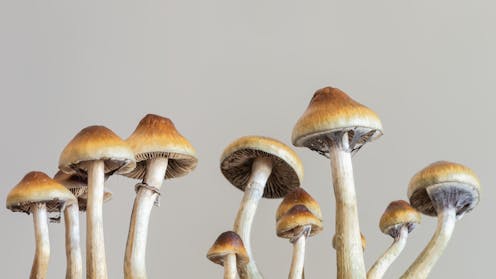Source: The Conversation – UK – By Sarah Olive, Senior Lecturer in Literature, Aston University
As pupils head back to school, they may well encounter Shakespeare’s plays and poems – perhaps for the first time.
I have written about books on Shakespeare’s life or plays for children and young adults for the last three years: fiction and fact, picturebooks and graphic novels, early readers to full-blown novels. Here are my top ten texts that take Shakespeare, run with him, and sweep up readers as they go.
Authors writing about Shakespeare for young people are surprisingly consistent in sticking to widely accepted scholarship. Authors’ notes often acknowledge the academic research that inspired them.
Readers are likely to come away from these books with greater understanding of Shakespeare, some pressing questions about him, and – above all – the experience of reading for pleasure. They are listed roughly in order of reading age.
1. The Boy, the Bear, the Baron, the Bard by Gregory Rogers, 2004
The young protagonist of this wordless picture book boots a football through time and onto Shakespeare’s stage, sparking an irate bard’s pursuit of him through a gorgeously-drawn Elizabethan London.
The boy quickly finds allies in his flight – rescuing a caged bear and an imprisoned noble. He even lands on the royal barge, in time for a dance with Queen Elizabeth I and courtiers. All’s well that ends well, but re-reading will enable you to spot quirky details in the drawings and put words in the characters’ mouths.
2. Bold and Brave Women from Shakespeare by Anjna Chouhan and the Shakespeare Birthplace Trust (authors), Becca Stadtlander (illustrator), 2024
The organisation that looks after Shakespeare’s houses in Stratford-upon-Avon has created this picture book anthology, with short sections on separate figures.
While its title has echoes of Mary Cowden Clarke’s 1850 book, The Girlhood of Shakespeare’s Heroines, its content departs from her Victorian moralising. The depiction of characters, from Cleopatra to Lady Macbeth, offers feminist overtones and a range of skin tones.
3. Rock Bottom by Ross Montgomery (author) and Mark Beech (illustrator), 2020
One instalment in a series of four “Shakespeare Shake-ups”, this book for primary schoolers retells the story of A Midsummer Night’s Dream using the familiar devices of children staging a school production and plans to impress a crush crashing.
I have laughed out loud reading these books. They tell relatable stories about friendship, awkwardness and teacher-pupil tensions. You might forget the plots are from the plays, they’re so deftly retold, but Shakespeare buffs will enjoy spotting allusions.
4. Much Ado About Nothing by Steve Barlow and Steve Skidmore (adapters), Wendy Tan Shiau Wei (illustrator), 2022
My favourite in a series of six editions of Shakespeare’s plays in graphic novel form. Each has a pithy, modernised text and resources at either end of the book to support readers’ understanding of both the play and the period.
Much Ado also exemplifies the series’ commitment to diversity. Importantly, this gels with the diverse casts students are likely to see in contemporary films and performances of Shakespeare, and reflects the ethnic diversity of school (and national) populations.
5. King of Shadows by Susan Cooper, 1999
From a popular British fantasy writer for children, this novel was significantly inspired by the reconstruction of Shakespeare’s Globe theatre in London. It’s the most compelling of a slew of Globe-focused theatre adventures published at the turn of the millennium.
A stage-mad American boy, grieving his parents, time-travels to early modern England and is mentored in acting – and surviving loss – by Shakespeare, who mourns his dead son, Hamnet. Plague contagion allows for some top-notch body swapping.

David G40/Shutterstock
6. Cue for Treason by Geoffrey Trease, 1940
The original “children-in-disguise go on Shakespeare’s stage” novel – at least for me. It was a class text at the end of primary school. It differs from King of Shadows in opening with travelling players touring the Lake District, although it takes in London’s early modern glitterati later. Real historical figures abound and are delightfully shady, as in biographical Shakespeare fiction generally.
7. The Dark Lady by Akala, 2021
This take on destitute children in Elizabethan London running into a kindly, father-figure Shakespeare has various unique qualities. One is balancing the main plot about Henry, a pickpocket who has the supernatural ability to read any language, with cryptic fragments from “the Dark Lady” of Shakespeare’s sonnets, for whom the book is named. Here, she is imagined as the descendent of an African ruling elite.
Akala is a Black British rapper and writer, whose work prominently features Shakespeare – though there are lashings of Charles Dickens’ Oliver here too.
8. Love Disguised by Lisa Klein, 2013
Adolescent Shakespeare opens this novel narrating his Stratford childhood, his father’s business woes, and plans to rescue his family’s fortunes while working in the theatre. In addition to having Shakespeare as the protagonist, this book offers an unusual explanation for his wife Anne Hathaway’s pregnancy before marriage. This is territory well-trodden by scholars, but Klein inventively borrows plotlines from Shakespeare’s Measure for Measure and All’s Well that Ends Well in her interpretation.
9. Saving Hamlet by Molly Booth, 2016
In the vein of Hollywood Shakespeare movies, the narrator’s high school is staging Hamlet and it’s going disastrously. The novel mashes up this genre with time-travelling theatre adventure, so that assistant-director Emma moves back and forth at will between two theatre worlds. The ideas she gleans from each benefit the other, so two high-stakes productions of Shakespeare’s famous tragedy are saved.
Theatre-kids will enjoy a writer who really knows her stuff: oft-overlooked tech crews are well-served by details of lighting and sound production. Saving Hamlet features several modern-day lesbian and gay main characters, with contrasting experiences of coming out.
10. Juliet Immortal by Stacey Jay, 2011
I came to this book because of the Twilight saga, and so may young readers with a taste for paranormal romance. It is set among teens staging Romeo and Juliet at their California high school. Narration is split between a modern-day girl, Ariel, and the undead Juliet.
The story deals superbly with consent, relationship violence and toxic masculinity – all elements of the play that literary critics have acknowledged – and also models positive alternatives. For those whose vampiric appetites aren’t sated, there’s an equally-gripping sequel: Romeo Redeemed.
This article features references to books that have been included for editorial reasons, and may contain links to bookshop.org. If you click on one of the links and go on to buy something from bookshop.org The Conversation UK may earn a commission.
![]()
Sarah Olive is a member of the British Shakespeare Association’s Education Committee (a registered charity) and founding editor of the free, online magazine Teaching Shakespeare.
– ref. Shakespeare for children: an expert’s top ten books to spark their imagination – https://theconversation.com/shakespeare-for-children-an-experts-top-ten-books-to-spark-their-imagination-263490











